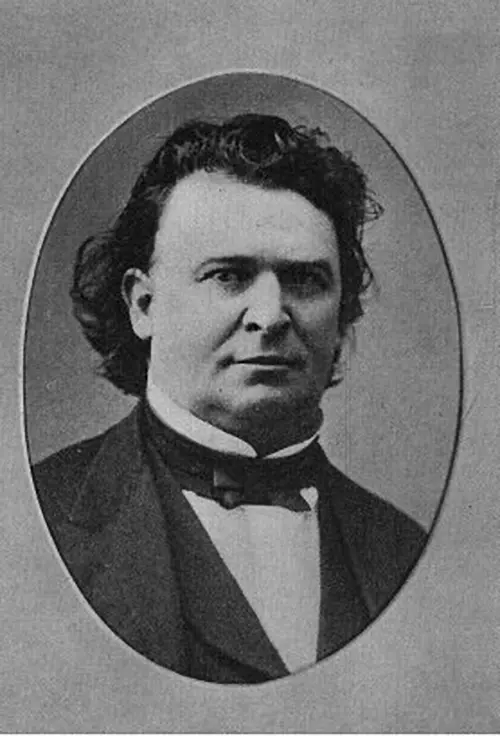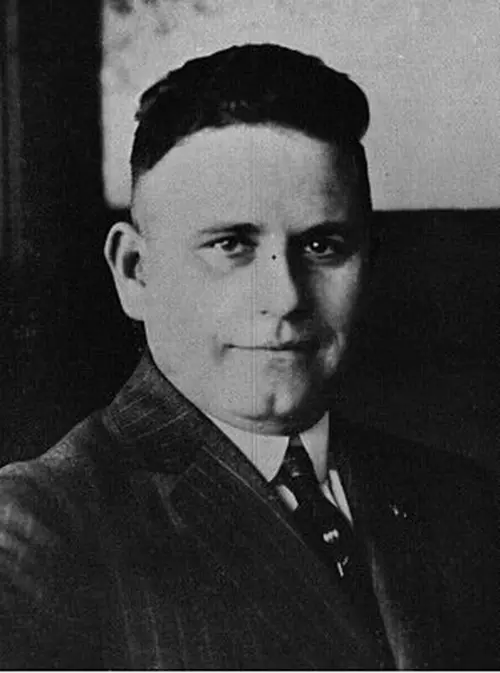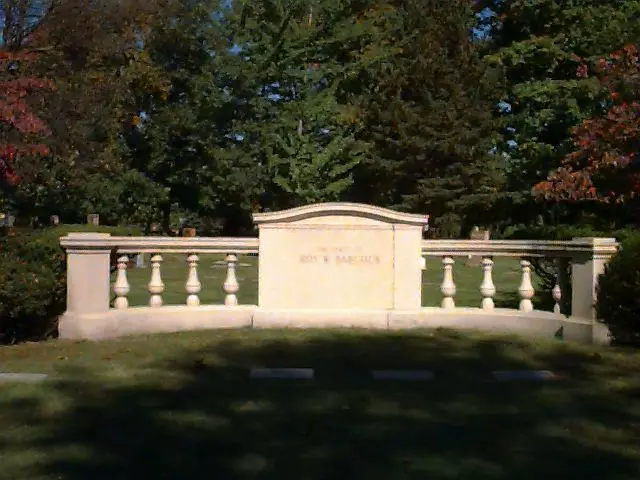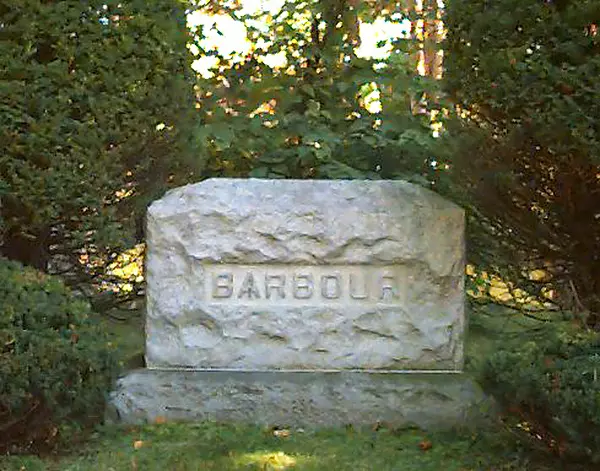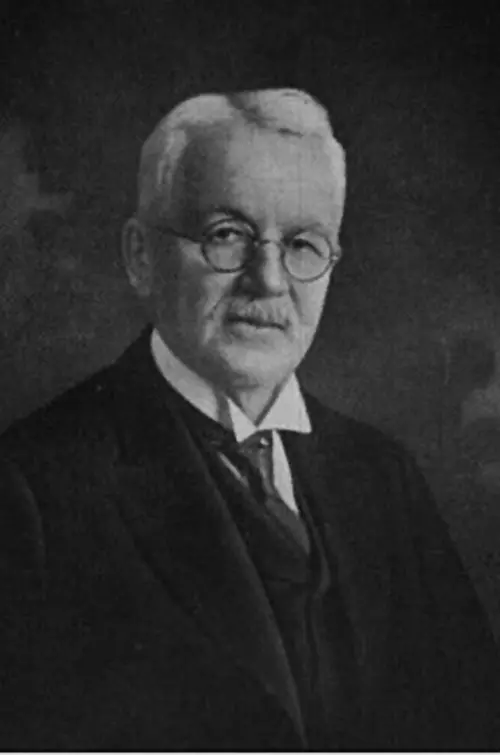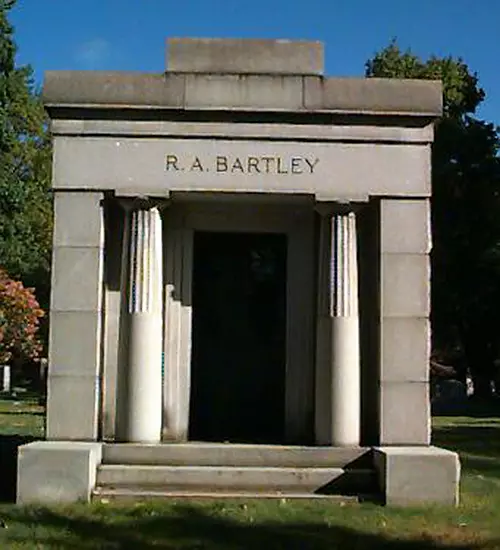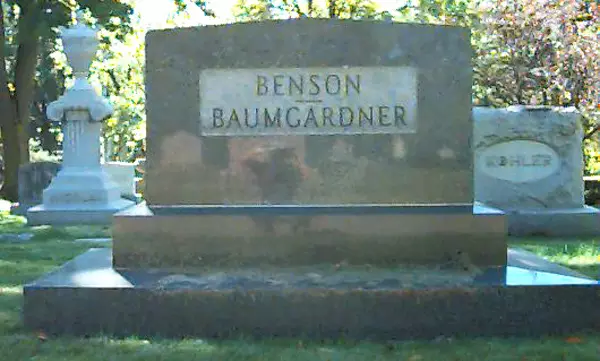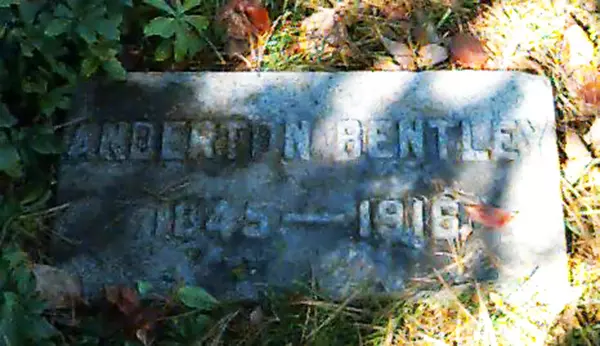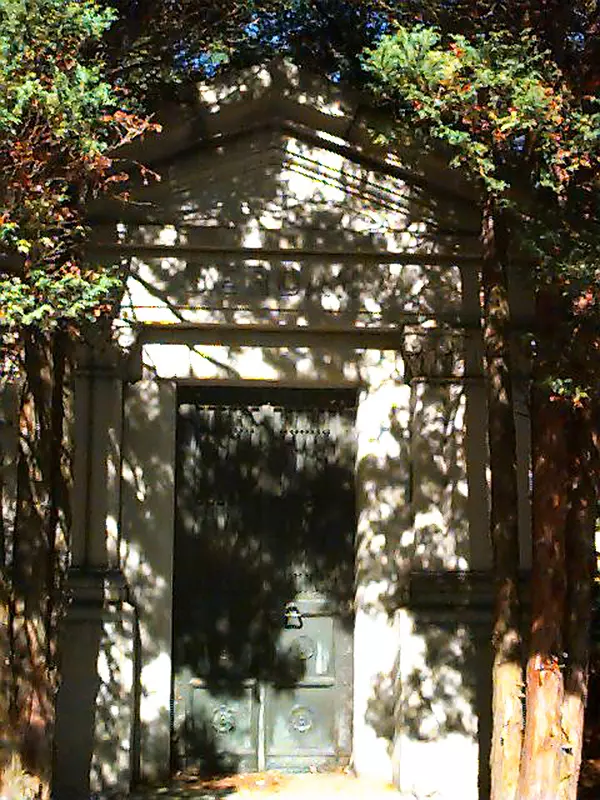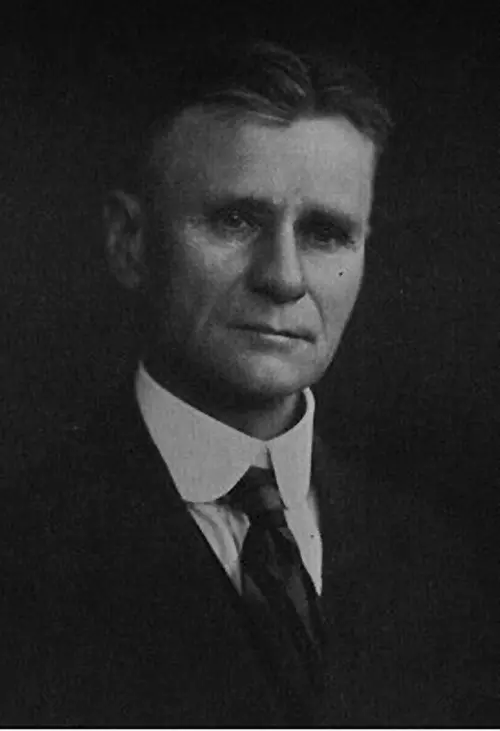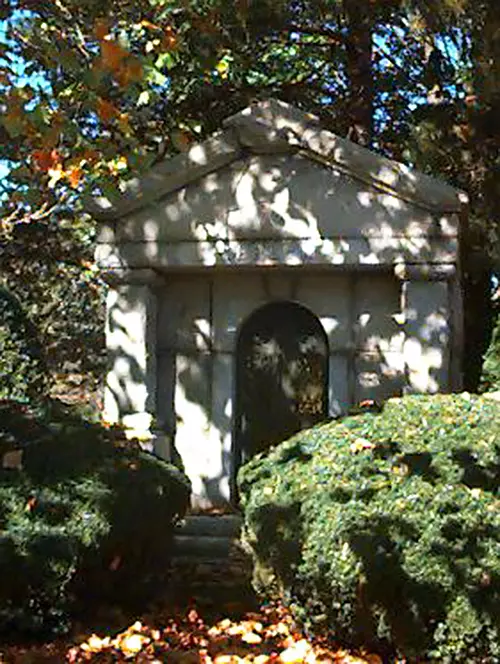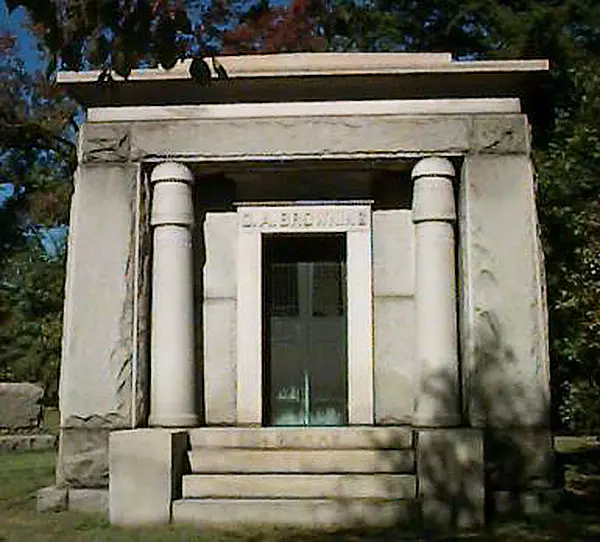James Ashley, Sr. - Roy William Babcock - Marcus Barbour - Rudolph A. Bartley - James Baumgardner - Bentley Family - John Berdan - Charles H. Breyman - Otis Avery Browning
James Ashley, Sr.
James Ashley, Sr. was born in 1824 in Allegheny County Pennsylvania.Unless otherwise noted all information is included in R. Horowitz, "James A. Ashley: A Biography" (Ph.D. diss., The City University of New York, 1973). Two years later, the Ashley family moved to Portsmouth, Ohio in the southeastern part of the state. As the son of an ordained minister, James Ashley received much of his education at home from his parents. During his early years in Portsmouth, young Ashley became aware of the evils of slavery.
At age sixteen, Ashley ran away from home to serve as a cabin boy and clerk on the numerous boats that traveled the Ohio and Tennessee Rivers. After several years of wandering and self-reflection, James returned to Portsmouth. With the help of Edward Johnson, he established the Portsmouth Democrat, but published only two issues because of a lack of funds. Failing at the newspaper business, Ashley studied law under a local attorney and was admitted to the Ohio bar in 1849. A lack of interest, however, meant that he rarely practiced law.
During his years in Portsmouth, Ashley became active in the underground railroad, which helped slaves escape to the north. By 1851 he no longer felt safe in southeastern Ohio and decided to move to Minneapolis, Minnesota. On his way west, however, Ashley made a permanent stop in Toledo. During a short trip home to Portsmouth in November, Ashley married Emma J. Smith. Returning to Toledo with his new bride, Ashley opened a drug store. Two years later he began publishing The Monthly Visitor with the intention of advertising his business.
Ashley ran a relatively successful pharmaceutical store, but his interests turned to politics. His hatred of slavery turned his interest to a passion and Ashley dreamed of one day running for a seat in the United States Congress. Following these instincts, Ashley secured a delegate's position to the 1856 Republican National Convention. When he returned to Toledo, Ashley and his fellow Republicans devoted much energy to promotion of the Republican nominee, John C. Fremont. Although they were unsuccessful, Ashley's campaigning and h4 anti-slavery sentiment helped him win election in 1858 to the U.S. House of Representatives.
Ashley dedicated his political life to the abolition of slavery. His record as a congressman and his h4 anti-slavery stand are well documented. The highlight of his political career came in 1863 when Ashley introduced the first proposition to amend the U.S. Constitution and abolish slavery. In 1865 he helped to secure passage of the thirteenth amendment. Two years later, he played a key role in the effort to impeach President Andrew Johnson.
In 1868, Ashley lost his bid for reelection to Congress, but he did not give up the political life. President Ulysses S. Grant appointed Ashley as governor of Montana Territory, but his harsh criticisms of the republican administration led to his removal from that office in 1869. Ashley returned to Toledo to practice law and switched his political allegiance to the Democratic Party. In 1875, the Ashley's, including their son, James Jr., moved to Ann Arbor, Michigan where Ashley became interested in the possibility of building a railroad extending from Toledo to the Michigan peninsula. Always the man of action, James, Sr. purchased several railroad terminals in Toledo and, with the help of James Jr., began building the extension which soon became known as the Toledo, Ann Arbor and Northern Michigan Railroad. The line began regular service on July 1, 1878. For the next sixteen years Ashley devoted the majority of his time to the railroad.
In 1893, Ashley suffered a severe attack of diabetes. While on a fishing trip in the summer of 1896, he became sick again. On September 16, he died from a heart attack. His body was returned to Toledo for interment at Woodlawn Cemetery a few days later.
James Ashley, Jr. was born in Toledo in 1854. He received his primary and secondary education there and then attended Cornell University. Ashley moved to Ann Arbor with his parents and while there earned a law degree from the University of Michigan. ("Jim Ashley, Railroader, Patriot, Dies," Toledo Blade, 3 November 1919.) In 1875, his father put him in charge of construction for the Toledo, Ann Arbor and Northern Michigan Railroad Ibid. Later, James Jr. helped to design the first car ferries for use on the Great Lakes. He also built water-power plants in Maumee and Defiance (Ibid.). Ashley became a prominent member of Ohio's Republican party. After the outbreak of World War I, Ashley joined the activities of such patriotic groups as the Defense League, the Liberty Loan and the Red Cross. James Ashley, Jr., died of a heart attack in November 1919.
(Photography of Woodlawn Cemetery by Josef Schneider.)
Roy William Babcock
The Babcock family moved to Toledo prior to the Civil War, when much of the area was yet undeveloped. Roy William Babcock was born on March 19, 1892. He followed in his family's footsteps and also blazed new trails.
Babcock grew up in Toledo and attended grammar and high school in the city. After graduation he began his career in the milk business on his father's dairy farm but quickly established an independent operation named the Babcock Dairy Company. In 1919, Babcock built a major plant which was equipped for the pasteurization of milk and cream. The Babcock Dairy Company became the largest independent dairy in the country, utilizing forty-one employees. Babcock conducted his business along progressive lines creating a high degree of efficiency in management.
Babcock married Ruth Margaret Probeck on August 17, 1915. He served as president of the Toledo and Ohio Milk Distributors Associations and was a 32nd degree Mason. When Babcock died suddenly on July 4,1944, his son, Wayne Babcock, took over the dairy.
John M. Killits, ed., Toledo & Lucas County, Ohio, 1623-1923 (Chicago and Toledo: The S.J. Clarke Publishing Co., 1923), Vol. 1, p. 81-82.
"Roy W. Babcock Dies Suddenly at Resort," Toledo Times, 5 July 1944.
Killits, p. 22. "Roy W. Babcock Dies Suddenly." Babcock -
(Photography of Woodlawn Cemetery by Josef Schneider.)
Marcus Barbour
Marcus Barbour, one time president of the Woodlawn Cemetery Association, was a prominent Toledo business man during the later years of the nineteenth century. A native of Vermont, Barbour moved to Toledo in 1872 with William Gosline Sr. to establish the coal firm Gosline and Barbour.
As a respected businessman, Barbour circulated within the thriving social and economic circles of late nineteenth and early twentieth century booming Toledo. For example, he joined the prestigious Toledo Club. In addition to running his coal company, Barbour served as director of the Commerce Guardian Trust and Savings Company. The Barbour family built its home at 2030 Scottwood Avenue, in the center of an area where Toledos most prominent citizens lived. ( Toledo Biography Scrapbook (Bargo-Bea), Local History Collection, Toledo/Lucas County Public Library; Toledo Blade, 20 September 1921.)
In 1886, the Gosline and Barbour Company, with headquarters at 160 Summit Street, was recognized as the city's oldest coal firm. (Leading Manufacturers and Merchants of Ohio (New York: International Publishing Company, 1886), p. 57.) Between 1872-1886, the company had extended its trade into Michigan, Indiana, Illinois, and by way of the Great Lakes into the Northwest region of the country. Gosline and Barbour owned two large mines in Ohio--the Shawnee Company in Perry County and the Jackson Company--which yielded the two leading grades of coal in the state. The Furnace Mine at Shawnee employed 200 men and the Jackson mine employed about 50. In 1892, each mine produced between 800 and 1,200 tons of coal per day. The high quality of the fixed-carbon coal allowed for its use in steam raising purposes and by the railroads. The company honored a policy to maintain a high quality in all the grades of coal that it handled.
The location of the Gosline and Barbour mines enhanced their productivity and their accessibility to their customers was their location. Both were situated along the lines of the Baltimore and Ohio, the Ohio Southern and Dayton, and the Pittsburgh, Ft Wayne, and Chicago Railroads. These advantageous locations for the collecting and shipping of coal enabled the firm to operate at minimum expense and offer to their customers the lowest possible freight weights. Gosline and Barbour earned an honorable reputation because of keen business practices such as keeping a large supply of coal on hand and promptly filling orders.
In addition to managing their coal company, Gosline and Barbour acted as selling agents for the Reading Coal and Iron Companies, Panders Company, the Delaware and Hudson Canal Company, and the J. Langdon Company. By the 1890s, Barbour and his partner gained a reputation as men who were interested in the development and growth of this metropolis. [The Industrial Advantages of Toledo, Ohio (Toledo: James P. McKinney, 1892), p. 31.]
Marcus Barbour, leading coal dealer, Toledo booster, and former president of the Woodlawn Cemetery Association, died in Vermont of apoplexy on September 19, 1921. (Toledo Blade, 20 September 1921.)
(Photography of Woodlawn Cemetery by Josef Schneider.)
Rudolph A. Bartley
Rudolph A. Bartley, an immigrant boy who became a great merchant, spent fifty years as one of Toledos most prominent wholesale grocers during the city's booming commercial and economic era of the late nineteenth century. Born in Wittenburg, Germany in 1851, Rudolph and his parents moved to Perrysburg, Ohio two years later.[Toledo Biography Scrapbook (Barbo-Bea), Local History Collection, Toledo/Lucas County Public Library and Toledo Times, 8 March 1927.]
In 1868 young Bartley hoped to leave the family farm to search for work in Toledo. His father agreed to let him go under the strict stipulation that his son send part of his monthly wages home to cover his absence from the farm.
Bartley set out for the city and soon became associated with the grocery trade when he found a job at the H.F. Barnes store, currently the site of the Valentine Theater. Barnes paid him $8 a month and gave him three meals a day. A year later Bartley found a new position with the J.A. Speyer store located at 307 Summit Street. He wages slowly rose to $35 a month so that by 1872 he had paid his debt to his father (the equivalent of $15 per week until Bartley came of age) and saved $200. He also managed to obtain a $100 loan.Charles S. Van Tassel. [Story of the Maumee Valley, Toledo and the Sandusky Region. 4 Vols (Chicago: St. Clair Publishing Co., 1929), Vol. 3, p. 130.]
At age 21, Bartley started a partnership in the grocery business under the name Cousino and Bartley. To save money, the partners did not hire any other employees and they slept in the store.John M. Killits, ed. [Toledo and Lucas County, Ohio 1623-1923. (Chicago and Toledo: The S.J. Clarke Publishing Co., 1923), Vol. 3, p. 31]. They delivered goods from a red pushcart with the name "Cousino and Bartley Groceries" painted on the side of it. This retail trade grew and prospered.Van Tassel, p. 130. In 1882, Bartley bought out Cousino's interest in the store and also purchased the retail grocery of J.C. Wueffel. (Killits, p. 31.)
Bartley discarded the retail aspect of the business and embarked exclusively on a wholesale grocery trade. With the expansion of his company came the proliferation of Bartley-owned warehouses. Beginning in 1897 the group of buildings that his company utilized spread down Lynn Street to Cherry Street on Summit until 1900 when his warehouses occupied this entire expanse of prime downtown real estate.
Wholesome, honest business practices earned Bartley not only an enviable reputation among Toledo business men and a loyal clientele among Toledo residents, it also benefited him financially. In 1904 the business, not yet 20 years old, had grown to a profitable five million dollar a year company. Bartley believed in sharing the wealth with his employees who had helped him to build his humble trade into a profitable business. He was one of the first business men in the area to inaugurate a bonus system and between 1904-1920 he divided $385,227 among his employees. In 1920, he converted his business into a closed corporation and distributed, depending on length of service, large blocks of stock to his workers which enabled them to enjoy the benefits of annual dividends.
In 1908 fire destroyed the Bartley Building. Bartley used built a new seven story headquarters at Washington and Ontario Streets, using fire proof materials. The building was the highest point in the Toledo's business district at the time. The Bartley wholesale grocery business became the largest individually owned grocery business in the Midwest.
Rudolph Bartley exhibited the civic and social responsibility expected of a prominent, wealthy business man during this period in Toledos history. He charismatic nature led to extensive and socializing with his colleagues and he also enjoyed a friendly relationship with his customers and employees. He greeted customers personally and although his desk was positioned so that his back was facing the front door of the building, a strategically placed mirror alerted him to a client's arrival.
In 1906 Bartley built a palatial residence at the corner of Collingwood and Jefferson Streets. He entertained friends and employees alike at the "Bartley Mansion." His generosity extended to local charities as well. For example, in early 1900s he donated $200,000 to the First Baptist Church, making possible the addition construction of its building on Collingwood near Central Avenue.
Bartley's community service extended to local politics. As a friend to Samuel "Golden Rule" Jones, he worked for the reform mayor's re-election. Bartley ran for mayor against Brand Whitlock in 1907 but was defeated due to the h4 Independent movement that dominated Toledo politics at that time. He turned his attention to local civic improvements and served as a two term president of Toledo Business Mens Chamber of Commerce and for five years as a member of the board of elections. He also sat as a director of the Commerce Guardian Trust and Savings bank, as president of the Adams Street Mission, trustee of the First Baptist Church, and director of the Toledo Humane Society. He was a member of the Toledo Yacht Club and a 32nd degree Mason.
Bartley married Hattie Josephine Barnes Dutton of Adrian, Michigan. He adopted his wife's children from a previous marriage, Charles and Virginia. The Bartleys adopted another son, Harry, from the Franklin Company Orphan's Home and took in his brothers, Frank and David. Active in the Toledo community, Hattie gained a reputation for her charitable work. She supported the First Baptist Church and contributed $50,000 to the Baptist Old Folks home and $10,000 to the Salvation Army. At the same time, she worked as accountant and bookkeeper for her husbands business. (Killits, p. 31 and Van Tassel, p. 132.)
Bartley gained renown in the Toledo are for his energy and stable, honest foundations. He died in his home on March 8, 1927 at 75 years old. Hattie Bartley died in early December 1928. Both are interred in the Bartley family mausoleum at the Woodlawn Cemetery.
(Photography of Woodlawn Cemetery by Josef Schneider.)
James Baumgardner
James Baumgardner served as senior partner of Baumgardner and Company, a pioneer dry goods company in Toledo. As a prominent businessman in Toledo, he spent sixty years of his life with the company.
Born in Wooster, Ohio in 1859, Baumgardner grew up in his father's historic hotel and house. At the age of thirteen, he moved with his brother Edson W. Baumgardner to Toledo where he attended high school. At eighteen, James entered the dry goods business under the tutelage of his uncle, L.S. Baumgardner. Young Baumgardner began as clerk, but quickly advanced to a sales position that covered the area of northwestern Ohio. In 1881, the firm accepted him as a partner.
James Baumgardner married Mary Benson in 1882 and together they had a son and daughter. He worshipped at St. Mark's Episcopal Church and belonged to the Chamber of Commerce, the Toledo Country Club, and the Toledo Club. As a Mason, he belonged to the Sanford L. Collins Lodge.
At 78 years old Baumgardner fell victim to bronchial pneumonia. He died on January 10, 1937 and is interred in Woodlawn Cemetery. [Toledo Biography Scrapbook (Barbo-Bea), Local History Room, Toledo/Lucas County Public Library].
Baumgardner's three nephews (sons of brother Edson), Frank L., Edson, L. and Carleton M. Baumgardner all became members of the firm. Edson L. Baumgardner, better known as Ned was born in Toledo on October 27, 1880. He attended public schools, the Michigan Military Academy, and then Cornell University where he was a member of the Psi Upsilon fraternity. After graduating from Cornell in 1903, he became a member of Baumgardner and Company. [John M. Killits, ed., Toledo and Lucas County, Ohio 1623-1923. (Chicago: S.J. Clarke Publishing Co., 1923), Vol. 3, pp. 376-77.]
Three years later he married Ms. Kaleannim and they became the parents of a son, Edson W. Like his uncle, Ned became active in several local sports and social clubs. He held memberships at the Inverness Club, Toledo Club, the Pere Marquette Rod and Gun Club, and the Middle Bass Island Club. He also enjoyed acting in amateur theater.
In November 1935, Ned Baumgardner fell ill from a heart ailment. The illness forced him to remain at home as an invalid until his death in June 1936.
Ned's brother, Frank L. Baumgardner, assumed the presidency of the Baumgardner and Company upon the death of his uncle. A native of Toledo, Frank was born on April 5, 1874. He obtained his early education in the Toledo area and then attended Peekskill Military Academy in New York during his adolescence and the University of Michigan. After graduation, Frank immediately joined the dry goods business. Until 1929, the company remained one of the leading dry goods wholesalers in the entire Midwest region.
Frank Baumgardner's active community life included membership in the First Congregational Church, the Toledo Club, the Chamber of Commerce, the Inverness Club, and many other organizations. He never married. Failing health forced Frank Baumgardner to sell the company. He died on October 9, 1939 at The Toledo Hospital and is interred at Woodlawn Cemetery. [Toledo Biography Scrapbook (Barbo-Bea).]
(Photography of Woodlawn Cemetery by Josef Schneider.)
Bentley Family
During the early twentieth century, the Bentley family name became synonymous with downtown Toledo development and construction throughout the city. One estimate stated that A. Bentley and Sons built three-fourths of the prominent buildings in Toledo. Anderton Bentley, a native of Bradford England, founded the family construction company. He originally settled in Adrian, Michigan with his wife, the former Elizabeth Robson. The firm gained a reputation throughout the Midwest as a result of Anderton's spirit of progressiveness, knowledge of the contracting trade, and managerial abilities. When he died in New York state on September 26, 1916, aged 72 years old, his sons James and Thomas became heir to one of Toledos foremost businesses. [Toledo Biography Scrapbook (Bea-Berd), Local History Collection, Toledo/Lucas County Public Library.]
The couple had three children; Ethel, James, and Thomas. Ethel was born in England in 1868 and while an infant she came to the US with her mother who was ill during the entire six week crossing. Her father followed in the fall of the same year. The Bentley's moved to Toledo in 1872 and Anderton entered the commercial life of the city as a builder and contractor.
Ethel graduated from Old Toledo Central High School in 1887 and became a teacher. She joined the Baptist church and was active in church work. Ethal later traveled for the Baptist mission to India, China, Burma, Japan, and other countries of the far East and was one of the first women to cross the Himalayas.
Thomas Bentley was born in Toledo on November 23, 1873. He married Katherine Lewis on November 30, 1898, in Defiance, Ohio. The couple had two sons, Anderton Lewis and James. Thomas Bentley had served as an apprentice plumber for three years under John A. Waite but abandoned that trade in 1894 and entered his fathers contracting business. When he became president in 1907, his brother James served as vice president. Thomas became active in other business ventures which included directorships in the Richardson Company--an investment banking firm, Toledo Steel Products Company, Second Mortgage Company of Toledo, and Commonwealth Building Company--owners and builders of the Secor Hotel.
Thomas Bentley also participated in Toledo politics. He generally reflected staunch Republican leanings when the ballot addressed national issues. But in local elections, he reserved the vote for the candidate he thought best qualified for the position. Thomas Bentley joined the top echelon of social and business circles in Toledo. He served as director of the Associate General Contractors of America and trustee of the Toledo Chamber of Commerce. He held memberships in the Elks Lodge, the Inverness Club, the Toledo Country Club, and was a 32nd degree Mason.
Among his many accomplishments, Thomas Bentley could claim the honor of being Toledos first street car conductor. He worked for the Toledo Consolidated Railway for $3.50 per week leading horses from Dorr Street car barns on the corner of Detroit Avenue to waiting street cars. He gained a reputation as an expert in the management of horses during these years. Thomas Bentley died on February 1, 1942 and is buried in the family plot at Woodlawn Cemetery.[Toledo Biography Scrapbook (Bea-Berd).]
After Thomas's death, James Bentley became president of the A. Bentley and Sons Company. [Toledo Biography Scrapbook (Bea-Berd).]
Born on November 1, 1871 in Lenawee County, Michigan, James moved with his parents to Toledo where he attended Central High School before joining his father's business in 1892. In addition to being president of A. Bentley and Sons, James served as vice-president of the Richardson Company and as a director of numerous other companies including Fifty Associates and the Commerce-Guardian Trust and Savings Bank, forerunner of First National Bank, of which he was president for many years. [John M. Killits, ed., Toledo and Lucas County, Ohio 1623-1923. (Chicago and Toledo: S.J. Clarke Publishing Co., 1923), Vol 3, pp. 180-83.]
From 1919 until 1930 James was in charge of the company office in Jacksonville, Florida, and met and worked with associates in the development of roads, railroads, and bridges. Between 1922 and 1927 James also directed construction work in Brazil, Cuba and the Dominican Republic.
James Bentley married the former Elizabeth Doyle Scott, daughter of Judge John Hurov Doyle. Their home, "Innisveil" was noted as one of Toledo's more attractive residences. James belonged to many social organization. He was a 32nd degree Mason, and a member of the Zenobia Temple Shrine. He held memberships in the Elks Club, the Toledo Chamber of Commerce, the Toledo Club, the Toledo Country Club, and the Carranor Hunt and Polo Club. James Bentley died on June 19, 1955, leaving no descendents. He did have a step-daughter Isabel though who later became Mrs. Celian Rorick. [Toledo Biography Scrapbook (Bea-Berd).]
The Bentley family construction firm began business under the name A. Bentley but when James joined in 1892 it became A. Bentley and Son.Killits, p. 183. Finally, in 1907, the name changed to A. Bentley and Sons. During the years that both brothers worked for their father, Thomas looked after the company's interests in the city while James involved himself with the projects outside of Toledo.(Killits, p. 548.)
The A. Bentley and Sons Company, in many ways, was ahead of its time in technology and scope. In 1883, when Anderton Bentley began re-building the Hall Block at the corners of St. Clair and Jefferson Streets, he coined the term skyscraper." The term referred to extra tall buildings that seemed to scrape the sky because of their height. The Bentley Company also used steel and tile as construction materials. This was a relatively new material in the building business at the time.
The company's main factories sat at the intersection of 13th Street and Clover Leaf Railway. Its headquarter was located at 201 Belmont Avenue. During the company's busiest season, it employed between 4-5,000 workers in addition to shop employees. Inside the factories, machines fabricated steel rods used in concrete works, a process specially designed by the Bentley Company. Examples of this new building phenomenon and the company's skill in concrete work can be seen in the Secor Hotel at Superior and Jefferson, the Thompson Hudson Company at Summit and Adams, and the Bostwick-Braun Building at Summit and Monroe. Bentley and Sons also built the twenty-one story Second National Bank Building.
Bentley construction appeared along the eastern seaboard states as well as throughout the Midwest. In 1917, the United States government commissioned the A. Bentley Company to erect draft stations for World War I in Chillicothe, Ohio and Jackson, Florida. The Bentley Company has built the majority of office buildings and factory buildings in the Toledo area ranging from the Toledo Museum of Art, Libbey-Owens-Ford Glass, Toledo Hospital and St. Vincents, to Davis-Besse and all the buildings for Toledo Edison. The Company was liquidated in 1982. [Hilda G. Bentley, The Bentley Lewis Story (1990) in the possession of Carol Bentley, p.23-24.]
(Photography of Woodlawn Cemetery by Josef Schneider.)
John Berdan
Toledo, Ohio incorporated as a city in the year 1837. During the same year, the city's residents elected John Berdan as their first mayor. [All information from Toledo Biography Scrapbook (Mayors), Local History Collection, Toledo/Lucas County Public Library.]
Berdan had been born in New York City on December 16, 1798. He married Pamela Freese and the couple moved to Brunswick, Ohio in Medina County. In Brunswick, Berdan held the office of the justice of the peace while working as a merchant.
The Berdan's settled in Toledo in September of 1835 where John formed a partnership with B.H. Peckham and Company, a commission and forwarding business located at the bottom of Lagrange Street. As local leaders in the business, most of the steamboats on the Maumee River stopped at the company's dock. Berdan's reputation as an astute business person gained him a reputation as a fair and honest individual. His popularity helped to assure his election as mayor.
Berdan's governing strategies earned him reelection in 1838 and at the end of his second mayoral term in 1839, the county commissioners named him associate justice of the Court of Common Pleas for Lucas County. He remained in this position until his death on October 11, 1841.
Berdan had two children, Peter F., a prominent man in the wholesale trade, and Rachel, wife of Valentine H. Ketcham. continued the reputable Berdan name throughout the Toledo community. The Berdan name lived on as part of the proud legacy of Toledo's boom days. A street name helps to remind local residents of the glorious past. Once a main thoroughfare in the outer region of Toledos suburbs, Berdan Avenue lies in the center of what is now a working class area of west Toledo.
(Photography of Woodlawn Cemetery by Josef Schneider.)
Charles H. Breyman
During the late nineteenth century, the Breyman name became closely associated with the marine contracting business in Toledo. The family owned and family operated G. H. Breyman Dredging Company played an important role in the city's development. George H. Breyman organized and presided over the company. His son, Charles H. Breyman, took over the business in 1910 when his father, at age 68, died in an automobile crash in Perrysburg Ohio.
Born in Toledo on March 10, 1866, Charles Breyman attended local public schools and then went to college at Columbia University where he earned the degree of Civil Engineer in 1889. He returned home after graduate to take a position with the Breyman Dredging Company. A year later, he accepted the appointment of assistant city engineer. During the ten years Charles Breyman oversaw the city sewer system and aided in the construction of the early foundation of the present system.
Between 1907-1917 Charles Breyman was associated with the Breyman ONeil Contracting Company. In 1917 he joined the G.H. Breyman and Brothers Company. While with the family company, the business became one of the leading dredging contractors in the country. Charles also served as a director of the National Dairy Company.
Charles married Mae Stevens, daughter of Mr. and Mrs. P.M. Stevens, a prominent Toledo family, on April 23, 1892. They were the parents of two children, Marie and William, who served in World War I. Charles Breyman circulated in numerous social circles including the Toledo Yacht Club, Toledo Automobile Club, Toledo Country Club, and the Toledo and Inverness Clubs. He also supported the Republican party. The family resided at 2229 Parkwood Avenue, in center of the city's premier neighborhood.
Charles H. Breyman died on March 2, 1945 and Mae Breyman passed away three years later in May of 1948. Both are buried in a lakeside mausoleum at Woodlawn Cemetery. [Toledo Biography Scrapbook (Boyd-Brid), Local History Collection, Toledo/Lucas County Public Library and The Blade, 6 March 1946.]
(Photography of Woodlawn Cemetery by Josef Schneider.)
Otis Avery Browning
Otis Avery Browning, a prominent Toledo businessman for over 55 years, was reputed to be, at the turn of the century, one of the city's richest men. A native of Norwich, Connecticut, Browning moved to Toledo at age 28 and established a publishing firm at Huron Street and Jefferson Avenue. [Toledo Biography Scrapbook (Browni-Burg) Local History Collection, Toledo/Lucas County Public Library and Toledo Blade, 3 August 1923.]
He entered the crude oil business in 1889 and there he built his fortune. He became well known throughout the state of Ohio for his activities in real estate and the oil land business. Browning's brother Clark joined him in a firm called Otis A. Browning and Company which set up over 150 wells in Wood County on tracts of oil land they had purchased there."Clark A. Brown, Former Banker, is Taken by Death," (Toledo Blade, 22 June 1931.)
Otis Browning's professional life spread beyond the oil business as he also became a prominent figure in Toledo financial circles. He served as director of the Second National Bank and Trust Company and vice-president of Security Savings Bank and Trust Company.
A sincere interest in city politics but a general dislike and distrust of politicians prompted Browning--when he wished to know how the wind was blowing--to circulate among working class voters. On the interurban lines, or over lunch in factories, Browing questioned working men about what they considered to be admirable qualities in politicians and why they did or did not vote for a particular candidate. Browning took these concerns seriously and made the opinions of his informants the foundation of his own civic and business policies and actions.
Browning's interests extended as well to literature, thus his early career as a subscription book publisher. His published works included a family Bible, New Testament, and a Bible commentary.
The citizens of Toledo, especially those of the south end, respected Browning as a city leader and as a successful businessman. His charismatic charm and commitment to the local area left a legacy after his death. Browning died in his home at 313 Broadway on July 28, 1923 at the age of 83. His will reflected his devotion to Toledo. The proceeds from a significant portion of his estate were provided for the establishment of a Home for aged Masons. [Extra info from Roger Klee, Eastman Smith, attys] Klee stipulates that the Browning will called for a home to be located on a suitable site of not less than 10 acres within 75 miles of the City of Toledo. The home was constructed, dedicated and is now located in Waterville, Ohio. Construction began in 1979. A large portion of his estate allowed for construction and maintenance of the home and for the purchase of paintings, furniture, and other personal items. Browning requested that the establishment resemble the Old Ladies Home in Toledo. The qualifications for admittance were related to master masons, and their wives or widows, they had to be sixty years or older, citizen of the U.S., member of a legal Masonic lodge in Ohio for at least six years, and good moral character. If not there were not enough masons to fill home, the will allowed for the admittance of superannuated clergy from various denominations.
Brownings will, a voluminous sixty-three pages filed in Lucas County, outlined the history of his rise to wealth and made reference to his personal philosophies on life and religion, including quotations from various hymns. In addition to the Masons, many other organizations received donations including the Palestine Chapter No. 5 of Eastern Star, Baptist Church Association of Preston City, Connecticut, and many family members. The directors of the Second National Bank, in a resolution to Browing, remembered him as "a man of h4 character, of rugged personality, of keen perception and of most excellent business judgment. These traits and qualifications combined to make him one of the most successful of the business men of the city. Otis Avery Browning is buried in a lakeside mausoleum at Woodlawn Cemetery.(Toledo Blade, 3 August 1923.)
Clark A. Browning, Otis' brother, also became a successful businessman and banker. A native of Preston, Connecticut where he had farmed and taught school, Clark Browning moved to Toledo in 1875 to join his brother in the publishing business. Later, he established a successful oil business with Otis Browning.("Savings Bank Founder, Oil Operator Dies," Toledo Times, 22 June 1931.)
The Brownings' accomplishments led them to control more oil interests in Oklahoma and Texas.("Expanding Years Have Been Kind to Trust Fund Willed for Masonic Home," Toledo Blade, 20 June 1959.)
Clark Browning entered banking with the Dollar Savings Bank in September 1901 as its first president. The institution shortly became the second largest bank in Toledo. After eight years it merged with the Ohio Savings Bank for which Browning served as vice-president, director, and member of the finance committee."Savings Bank Founder."
In addition to banking and oil, Browning speculated in real estate . With his purchase of many pieces of downtown property, he displayed a confidence in the growth of Toledo. His holdings included the Ashley Building on Jefferson Avenue. During Browning's lifetime his investments grew several times in value."Clark A. Browning," (Toledo Times, 23 June 1931. "Savings Bank.Founder.")
In his leisure, Clark Browning was a member of the Toledo and Inverness Clubs, a 32nd Degree Mason, and a member of the Zenobia Shrine.
Failing health forced his retirement from banking in 1917. Three years later he reentered private life completely."Savings Bank Founder." As his health improved, Browning took time to travel and only became seriously ill a month before his death on June 21, 1931. He was survived by his wife Harriet.
(Photography of Woodlawn Cemetery by Josef Schneider.)
James Ashley, Sr. - Roy William Babcock - Marcus Barbour - Rudolph A. Bartley - James Baumgardner - Bentley Family - John Berdan - Charles H. Breyman - Otis Avery Browning

